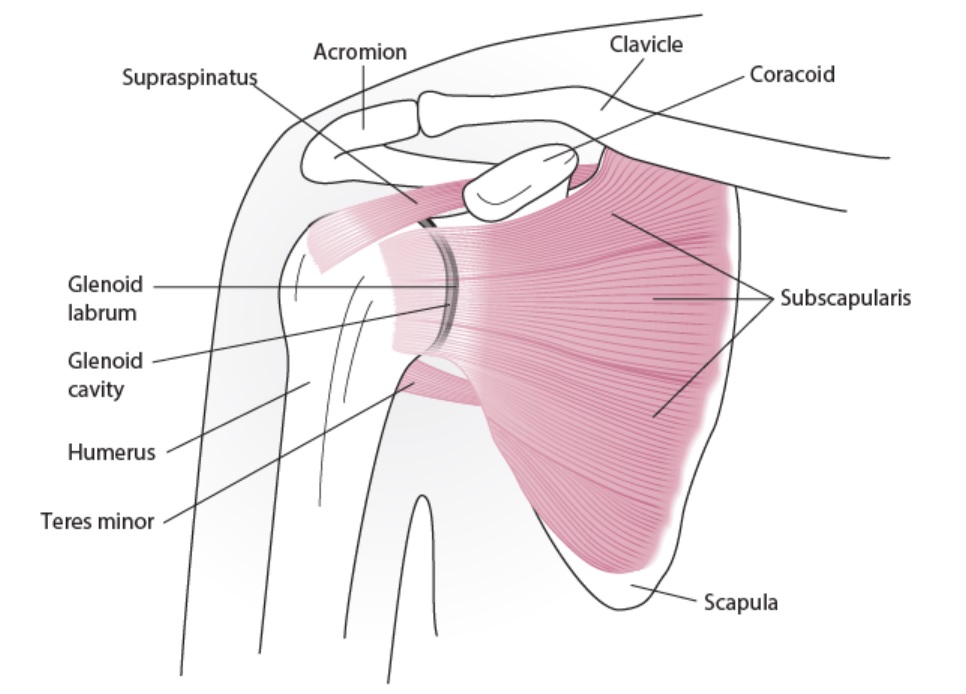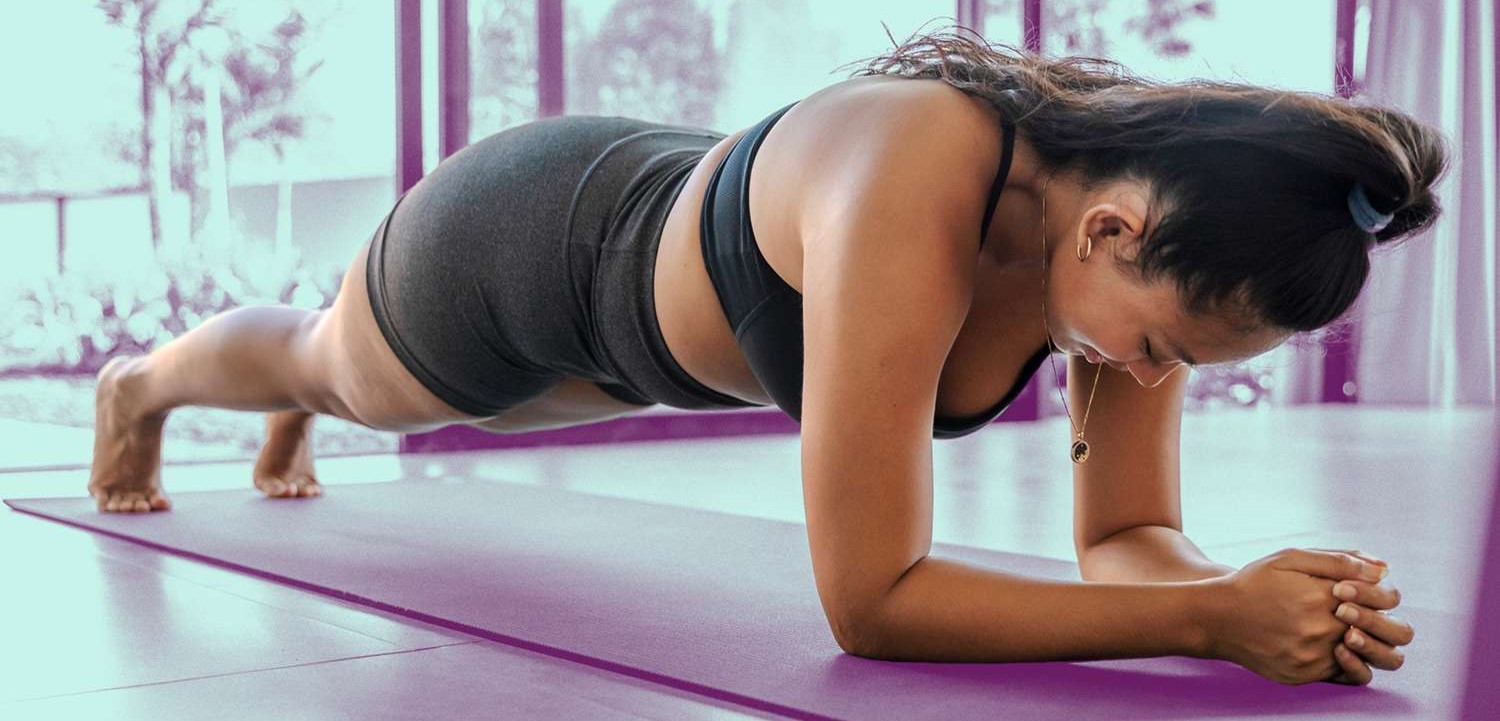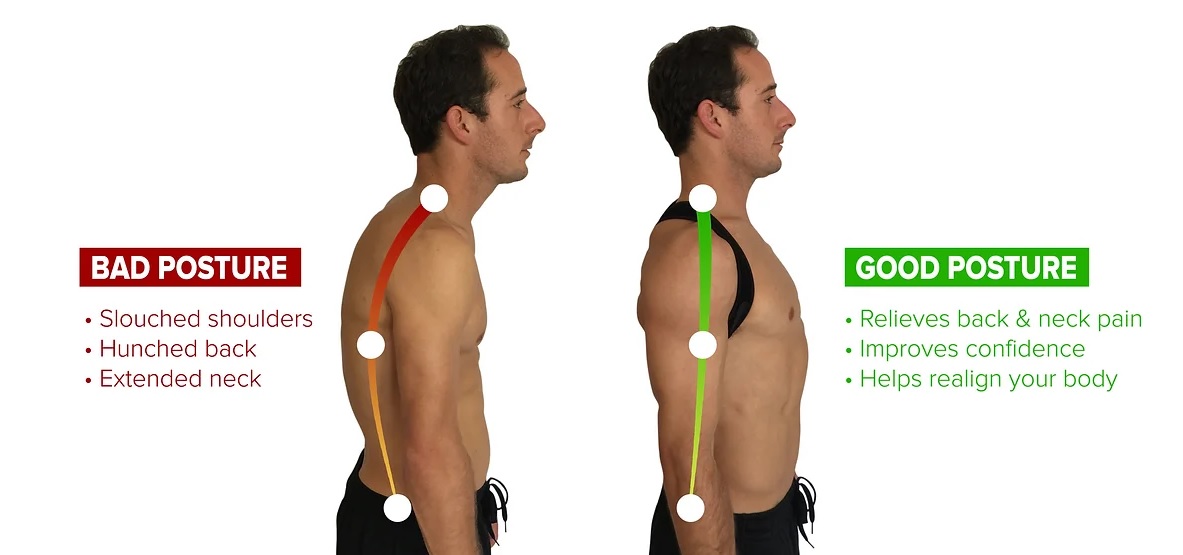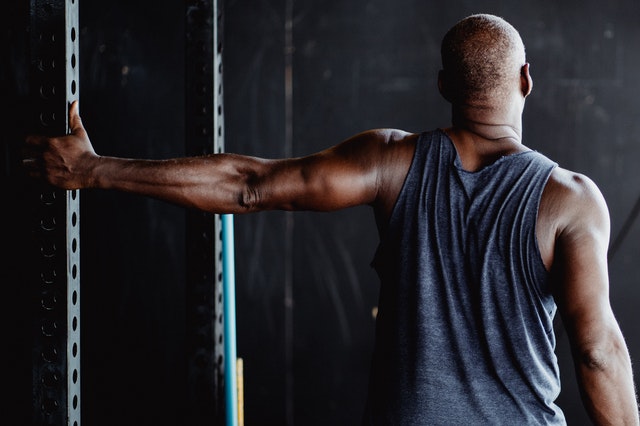Rounded shoulders, also known as kyphosis or slouched shoulders refer to a postural issue characterized by an excessive curvature of the upper back and shoulders. In this condition, the shoulders appear to be rolled forward, causing the upper back to round and the head to jut forward in front of the body’s natural center of gravity. This posture resembles a forward-leaning or hunched-over position and can have various causes and degrees of severity.
Anatomy of the Shoulder Musculoskeletal System
The shoulder is a ball-and-socket joint, known as the glenohumeral joint, where the head of the upper arm bone (humerus) articulates with the shallow socket of the shoulder blade (scapula). The key components of the musculoskeletal system in the shoulder include:
- Muscles: The shoulder is surrounded by a network of muscles, including the deltoid, rotator cuff muscles (supraspinatus, infraspinatus, teres minor, and subscapularis), and various scapular stabilizers. These muscles allow for the wide range of motion and stability of the shoulder joint.
- Tendons: Tendons are thick, fibrous tissues that connect muscles to bones. In the shoulder, the tendons of the rotator cuff muscles play a critical role in providing stability and controlling joint movement.
- Ligaments: Ligaments are strong, connective tissues that hold bones together. In the shoulder, ligaments such as the glenohumeral ligaments and the coracohumeral ligament help stabilize the joint.
- Bones: The primary bones involved in the shoulder are the humerus, scapula, and clavicle. The humeral head forms the ball of the ball-and-socket joint, while the shallow socket is part of the scapula.

The Impact of Inadequate Muscle Stretching on Rounded Shoulders
Proper muscle stretching is an often-overlooked yet crucial aspect of maintaining good posture and preventing conditions like rounded shoulders. The body’s intricate system of muscles and connective tissues relies on a delicate balance of tension and flexibility. When this equilibrium is disrupted due to inadequate stretching, it can lead to a cascade of physical issues, including rounded shoulders.
- The Role of Sarcomeres: Muscle cells consist of tiny contractile units called sarcomeres. These sarcomeres are responsible for the contraction and relaxation of muscles. When muscles are consistently kept in a shortened state due to insufficient stretching, the sarcomeres tend to adapt by remaining in a contracted position.
- The Shortening Effect: Inadequate stretching effectively shortens the muscle fibers, causing them to lose some of their length. Over time, as more and more sarcomeres remain contracted, the muscles become tighter and less flexible. This tightness pulls the shoulders forward and contributes to the characteristic hunched posture of rounded shoulders.
The Importance of Regular Stretching: Proper stretching is essential for maintaining muscle length, joint mobility, and overall flexibility. It helps prevent the chronic shortening of muscles and allows them to return to their optimal resting length. Regular stretching exercises that target the chest, shoulders, and upper back can help counteract the effects of muscle tightness and promote better posture.
The Power of Isometric Contractions
Isometric contractions are a form of resistance training where the muscle remains the same length while under tension. In the context of addressing rounded shoulders, isometric contractions are performed in a fully stretched position, often under a load or resistance. Here’s why it’s effective:
- Targeted Muscle Engagement: By applying resistance in a stretched position, isometric contractions engage the specific muscles responsible for maintaining proper posture.
- Muscle Balance: These contractions address muscle imbalances by strengthening the underdeveloped upper back muscles that often contribute to rounded shoulders.
- Immediate Post-Workout Window: Performing isometric contractions immediately after chest or shoulder workouts takes advantage of the muscles’ pumped state, making them more receptive to change.

Incorporating isometric contractions in a fully stretched position after chest or shoulder workouts offers several advantages:
- Postural Improvement: Regular practice can help correct rounded shoulders and promote better posture.
- Enhanced Flexibility: Isometric contractions in a stretched position can improve shoulder mobility.
- Injury Prevention: By reducing muscle imbalances, this technique can help prevent injuries associated with poor posture.
Remember to start with a manageable resistance and gradually increase it as you progress. Additionally, consult with a fitness professional or physical therapist to ensure you’re performing these contractions safely and effectively.
Finding Your Stretched Position
- Stand or sit up straight.
- Roll your shoulders back and down.
- Squeeze your shoulder blades together.
You’ll feel a stretch in your chest and front shoulder muscles. This is your stretched position.
How to Do Isometric Contractions
- Get into your stretched position.
- Try to push your palms forward without moving your arms.
- Hold for 10-15 seconds, feeling the muscles between your shoulder blades working.
- Repeat a few times and make it a daily habit.
Be Consistent
Do this exercise regularly to strengthen your upper back and shoulders, which will help fix rounded shoulders. Remember, this is just one part of correcting rounded shoulders. Combine it with other exercises and good posture habits for the best results.
Causes of Rounded Shoulders
The causes and contributing factors of rounded shoulders are multifaceted and can vary from person to person. Understanding these factors is essential for addressing and preventing this postural issue effectively. People who engage in training or weightlifting can sometimes develop rounded shoulders for several reasons:
- Poor Form: Incorrect exercise form, especially during exercises like bench presses or push-ups, can place excessive stress on the chest and front deltoids. If proper form isn’t maintained, it can lead to the development of rounded shoulders.
- Lack of Postural Awareness: Some individuals may not pay attention to their posture during workouts, allowing their shoulders to hunch forward. This lack of awareness can contribute to rounded shoulders over time.
- Overuse of Certain Movements: Repetitive movements that involve the chest and anterior deltoids, such as excessive bench pressing or push-ups, without sufficient attention to exercises that work the upper back can lead to muscle imbalances and rounded shoulders.
- Inadequate Stretching: Neglecting stretching and mobility exercises, especially for the chest and front shoulder muscles, can lead to tightness and limited range of motion. This can contribute to rounded shoulders as the tight muscles pull the shoulders forward.

Symptoms and Consequences
Neck and Shoulder Pain:
- Rounded shoulders strain neck and shoulder muscles.
- This can cause chronic pain and tension headaches.
Reduced Lung Capacity:
- Rounded shoulders compress the chest.
- Shallow breathing is common.
- Less oxygen intake can lead to fatigue.
Limited Range of Motion:
- Rounded shoulders restrict arm and shoulder movement.
- Tasks like reaching or lifting can become harder.
Appearance:
- Rounded shoulders make a person seem less confident and approachable.
- It affects how others perceive them and may affect self-esteem.
- You can address rounded shoulders through exercises and posture awareness.
Strategies to Prevent Rounded Shoulders
Preventing the development of rounded shoulders during training is essential for maintaining good posture and overall musculoskeletal health. Here are some effective strategies to help prevent rounded shoulders while training:
- Incorporate Posture Exercises: Include exercises that specifically target the muscles responsible for good posture. These include the muscles of the upper back, rear deltoids, and scapular stabilizers. Rows, face pulls, and band pull-aparts are excellent choices for strengthening these muscles.
- Balance Muscle Development: Ensure that you’re not overemphasizing certain muscle groups while neglecting others. For example, if you’re doing a lot of chest-focused exercises, balance them with exercises that target the upper back and rear deltoids. Balanced muscle development helps maintain proper shoulder alignment.
- Stretch Regularly: Incorporate regular stretching into your training routine to prevent muscle tightness and shortening. Focus on stretches for the chest, anterior deltoids, and other muscles that may contribute to rounded shoulders. Stretching can help maintain muscle length and flexibility.

- Use Ergonomic Equipment: If you’re using gym equipment, ensure that it is ergonomically designed to support good posture. Adjust seats, handles, and settings to fit your body properly and reduce the risk of poor posture during exercises.
- Warm-Up and Cool Down: Begin your training sessions with a proper warm-up that includes dynamic stretches and mobility exercises. After your workout, perform static stretches to relax and lengthen the muscles. A well-rounded warm-up and cool-down routine can help maintain flexibility and posture.
- Mindful Breathing: Practice mindful breathing techniques that encourage diaphragmatic breathing and chest expansion. Deep, controlled breathing can help keep your chest open and your shoulders back.
Self-Assessment To Identifying Rounded Shoulders
- Stand naturally with your arms at your sides, looking straight ahead.
- Stand in front of a mirror if possible, or use your smart phone camera.
- Head Position: Check if your head sticks forward from your body.
- Shoulder Alignment: See if your shoulders are hunched forward.
- Hand Position: Look at the direction your palms and thumbs are facing.
- Notice if you feel any discomfort in your neck, shoulders, or upper back.
- Try raising your straight arms overhead and pulling your shoulder blades back and together. Note any difficulty.
- Get a friend or take photos to help you see your posture from different angles.
- Compare your posture to what you know is proper, with your head aligned, shoulders back, and upper back straight.
If you notice signs of rounded shoulders, consider exercises, stretches, and being aware of your posture to improve it. If it’s causing discomfort, consulting a healthcare professional.
Full ROM Training for Better Posture and Fixing Rounded Shoulders
Full ROM (Full Range of Motion) means doing exercises that let your joints move as much as they can. It’s essential for better posture and shoulder health. Here’s why it’s helpful:
- More Flexible Shoulders: Full ROM exercises help your shoulder joints and muscles become more flexible. This makes it easier to stand tall and improve your posture.
- Less Risk of Injury: Rounded shoulders can cause muscle imbalances. Full ROM exercises fix these imbalances, making your shoulders more stable and reducing the chance of injuries.
- Stronger Muscles: Full ROM exercises work all the right muscles. This not only helps with rounded shoulders but also makes you stronger overall.
To make Full ROM training work for you, start with exercises that match your fitness level and gradually make them more challenging. This way, you’ll improve your posture and shoulder health over time.









